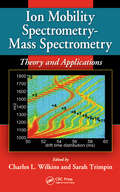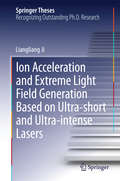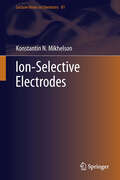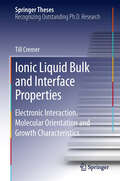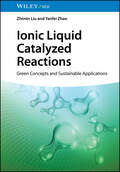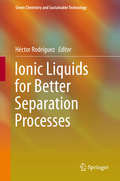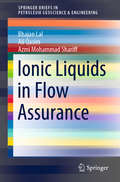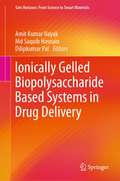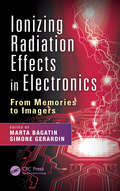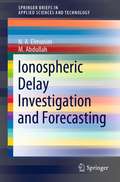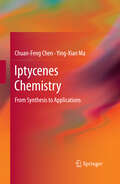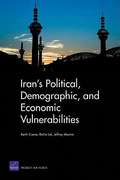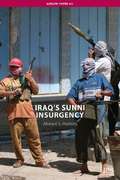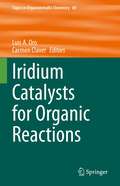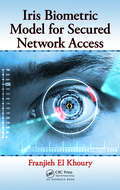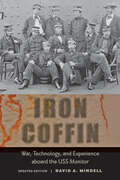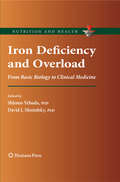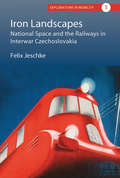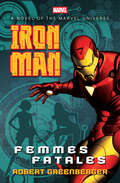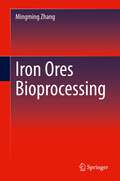- Table View
- List View
Ion Mobility Spectrometry - Mass Spectrometry: Theory and Applications
by Charles L. Wilkins Sarah TrimpinThe analytical power of ion mobility spectrometry-mass spectrometry (IMS-MS) instruments is poised to advance this technology from research to analytical laboratories. Exploring these developments at this critical juncture, Ion Mobility Spectrometry-Mass Spectrometry: Theory and Applications covers the tools, techniques, and applications involved when molecular size and shape information is combined with the well-known analytical advantages of high-performance mass spectrometry.One of the Most Exciting Developments in Contemporary Mass SpectrometryAfter presenting an overview chapter and the fundamentals, the book focuses on instrumentation and ionization sources. It describes an ion-mobility-capable quadrupole time-of-flight mass spectrometer, the differential mobility analyzer, a cryogenic-temperature ion mobility mass spectrometer, the atmospheric solids analysis probe method, and laserspray ionization. In the final applications-oriented chapters, the contributors explore how homebuilt and commercial instruments using electrospray ionization and matrix-assisted laser desorption/ionization (MALDI) methods are employed to solve biological and synthetic issues.Harness the Power of IMS-MS for Analyzing Complex SubstancesThis work helps readers unfamiliar with IMS-MS to understand its fundamental theory and practical applications. It also encourages them to investigate the potential analytical uses of IMS-MS and further explore the power of this method. Numerous color figures are included on downloadable resources.
Ion acceleration and extreme light field generation based on ultra-short and ultra-intense lasers
by Liangliang JiThis book is dedicated to the relativistic (laser intensity above 1018 W/cm2) laser-plasma interactions, which mainly concerns two important aspects: ion acceleration and extreme-light-field (ELF). Based on the ultra-intense and ultra-short CP lasers, this book proposes a new method that significantly improves the efficiency of heavy-ion acceleration, and deals with the critical thickness issues of light pressure acceleration. More importantly, a series of plasma approaches for producing ELFs, such as the relativistic single-cycle laser pulse, the intense broad-spectrum chirped laser pulse and the ultra-intense isolated attosecond (10-18s) pulse are introduced. This book illustrates that plasma not only affords a tremendous accelerating gradient for ion acceleration but also serves as a novel medium for ELF generation, and hence has the potential of plasma-based optics, which have a great advantage on the light intensity due to the absence of device damage threshold.
Ion-Selective Electrodes
by Konstantin N. MikhelsonIon-selective electrodes (ISEs) have a wide range of applications in clinical, environmental, food and pharmaceutical analysis as well as further uses in chemistry and life sciences. Based on his profound experience as a researcher in ISEs and a course instructor, the author summarizes current knowledge for advanced teaching and training purposes with a particular focus on ionophore-based ISEs. Coverage includes the basics of measuring with ISEs, essential membrane potential theory and a comprehensive overview of the various classes of ion-selective electrodes. The principles of constructing ISEs are outlined, and the transfer of methods into routine analysis is considered. Advanced students, researchers, and practitioners will benefit from this expedient introduction.
Ionic Liquid Bulk and Interface Properties
by Till CremerIn this thesis, Till Cremer investigates the bulk properties of ionic liquids (IL), the IL/vacuum interface and the IL/solid interface. For these studies the author primarily uses angle-resolved X-ray photoelectron spectroscopy under ultrahigh vacuum conditions. ILs represent a class of materials with unique physico-chemical properties. Many applications take advantage of the extremely low vapor pressure of aprotic ILs to fabricate permanent, non-volatile liquid coatings on solid materials. The author focuses on issues related to thin IL coatings, in particular concerning new catalytic concepts such as the supported ionic liquid phase (SILP) and solid catalyst with ionic liquid layer (SCILL) systems. Till Cremer presents a number of fundamental contributions to the new field of "Ionic Liquid Surface and Interface Science". Highlights are his results concerning anion/cation-interactions and the growth of ultrathin layers of ionic liquids on various substrates in the context of supported ionic liquid catalysis. His results have significantly contributed to the present level of understanding in the field and accordingly he is author and coauthor of ten publications on the topic in high-ranked journals.
Ionic Liquid Catalyzed Reactions: Green Concepts and Sustainable Applications
by Zhimin Liu Yanfei ZhaoUnderstand the applications of ionic liquid catalysis with this cutting-edge overview Ionic liquids have distinctive properties that have made them the subject of vigorous research in recent decades. They have primarily been seen as potential green alternatives to volatile organic solvents, and therefore as a vital tool in the development of sustainable industry. In fact, however, ionic liquids can also serve as catalysts, catalyst immobilizers, and initiators, with the result that they have been applied in over 100 known types of chemical reactions. Ionic Liquid Catalyzed Reactions: Green Concepts and Sustainable Applications offers a detailed overview of these reactions and the catalytic mechanism of ionic liquids. It surveys cutting-edge research into ionic liquid catalysis and the concepts, perspectives, and skills needed for scientists to incorporate it into a range of experimental fields. It is a must-own for anyone looking to understand the range and variety of uses for ionic liquid catalysis. Ionic Liquid Catalyzed Reactions readers will also find: Case studies throughout showing ionic liquid catalysis applications Information for scientists working in organic chemistry, electrochemistry, biotechnology, and many more Detailed coverage of reactions including CO2 conversion, biomass transformation, organic synthesis, and many others Ionic Liquid Catalyzed Reactions is ideal for catalytic chemists, organic chemists, environmental chemists, electrochemists, and anyone else working with chemical catalysis in need of new experimental methods.
Ionic Liquids for Better Separation Processes
by Héctor RodríguezThis book discusses capital separation processes of industrial interest and explores the potential for substantial improvement offered by a promising class of substances: ionic liquids. These low melting point salts, with their unique characteristics, have been gaining relevance in the field of separation through a variety of approaches. The chapters are structured from an application perspective, and cover the utilisation of ionic liquids in different unit operation contexts (distillation, liquid-liquid extraction, and solid-liquid extraction), giving an idea of their remarkable versatility. The final chapters focus on the use of ionic liquids in analytical applications based on separation procedures. This volume combines the review of the main advances to date with the analysis of the potential future use of ionic liquids in separation processes across a variety of fields, ranging from enhancement of state-of-the-art technologies to a revolution in the technological bases currently in use. It provides a valuable resource for engineers and scientists working in the field of separation, as well as for all readers generally interested in ionic liquids, in particular from an application standpoint. Héctor Rodríguez is a faculty member of the Department of Chemical Engineering at the University of Santiago de Compostela, Spain.
Ionic Liquids in Flow Assurance (SpringerBriefs in Petroleum Geoscience & Engineering)
by Bhajan Lal Ali Qasim Azmi Mohammad ShariffThis book focuses on the application of ionic liquids in flow assurance in the oil and gas industry. It discusses their physiochemical properties, and considers the role of ionic liquids as gas hydrate inhibitors in offshore pipelines. Gas hydrate occurrence can pose a major threat to pipeline integrity. Therefore, different categories of gas hydrate inhibitors and the main factors influencing ionic liquids during gas hydrate inhibition are examined thoroughly. The use of ionic liquids as corrosion inhibitors, their application in flow assurance industry to mitigate corrosion, and factors affecting their performance are discussed. Finally, the applications of ionic liquids in wax, scale and asphaltenes deposition control is explored. The extensive discussion of ionic liquids in flow assurance mean that this book will be of use to researchers, engineers, and industry professionals in upstream processing of the oil and gas sector.
Ionic Polymer-Metal Composites: Evolution, Application and Future Directions
by Srijan BhattacharyaThis book focuses on electro active polymer material known as Ionic Polymer Metal Composite (IPMC) having unique applicability as sensor and actuator which finds extensive use in various domain of engineering and science research. Apart from fundamentals of the IPMC concept, various applications are covered extensively across the chapters including space, underwater and nanoscale, including manufacturing processes. Dedicated chapters are included for robotics and biomedical applications and possible research gaps. Future research perspectives for IPMC are also discussed. Features: Covers principle of Ionic Polymer Metal Composite (IPMC), manufacturing processes, applications, and future possibilities in a systematic manner Highlights IPMC practical applicability in biomedical engineering domain Explores Single-walled carbon nanotubes (SWNT) based IPMC soft actuators Discusses IPMC applications in underwater areas Includes IPMC application in robotics focusing on special compliant mechanism This book is aimed toward researchers, graduate students and professionals in materials and mechanical engineering, robotics, mechatronics, biomedical engineering, and physics.
Ionically Gelled Biopolysaccharide Based Systems in Drug Delivery (Gels Horizons: From Science to Smart Materials)
by Amit Kumar Nayak Md Saquib Hasnain Dilipkumar PalThis volume provides a thorough insight into the chemistry and mechanism of ionic gelations of various ionic biopolysaccharides, like alginate, gellan gum, pectin, chitosan, carboxymethyl cellulose, etc., and the applications of various ionically gelled biopolysaccharides in drug delivery fields, with chapters emphasizing the recent advances in the field by the experts. This book will be of interest to graduate students and academic and industry researchers from pharmacy, biotechnology, bioengineering, biomedical and material sciences fields.
Ionizing Radiation Effects in Electronics: From Memories to Imagers (Devices, Circuits, and Systems)
by Marta Bagatin Simone GerardinIonizing Radiation Effects in Electronics: From Memories to Imagers delivers comprehensive coverage of the effects of ionizing radiation on state-of-the-art semiconductor devices. The book also offers valuable insight into modern radiation-hardening techniques.The text begins by providing important background information on radiation effects, their underlying mechanisms, and the use of Monte Carlo techniques to simulate radiation transport and the effects of radiation on electronics. The book then: Explains the effects of radiation on digital commercial devices, including microprocessors and volatile and nonvolatile memories—static random-access memories (SRAMs), dynamic random-access memories (DRAMs), and Flash memories Examines issues like soft errors, total dose, and displacement damage, together with hardening-by-design solutions for digital circuits, field-programmable gate arrays (FPGAs), and mixed-analog circuits Explores the effects of radiation on fiber optics and imager devices such as complementary metal-oxide-semiconductor (CMOS) sensors and charge-coupled devices (CCDs) Featuring real-world examples, case studies, extensive references, and contributions from leading experts in industry and academia, Ionizing Radiation Effects in Electronics: From Memories to Imagers is suitable both for newcomers who want to become familiar with radiation effects and for radiation experts who are looking for more advanced material or to make effective use of beam time.
Ionizing Radiation Technologies: Managing and Extracting Value from Wastes (Institute of Food Technologists Series)
by Suresh D. Pillai Shima ShayanfarIonizing Radiation Technologies An authoritative overview of major advances in the application of ionizing radiation technologies to industrial, agricultural, and municipal waste products In Ionizing Radiation Technologies: Managing and Extracting Value from Wastes, a team of expert researchers delivers a broad overview of the value trapped in waste streams and how a strategic application of ionizing radiation technologies can be valuable from both an environmental and an economic perspective. A valuable addition to the discussions around sustainability and green technologies, the book introduces ionizing radiation technologies, including gamma (cobalt-60) irradiation and high and low energy electron beam technologies. The contributions included explore the major advances taking place in the application of ionizing radiation technologies to derive high value end-products from agricultural, municipal, and industrial wastes. Each chapter reviews original research and data and considers likely future directions in research and development. The book also includes: A thorough introduction to the application of ionizing radiation technologies to agricultural waste, including the production of activated carbon Comprehensive explorations of the application of ionizing radiation technologies to municipal waste, including municipal solid wastes and recycling wastewater Practical discussions of the application of ionizing radiation technologies to industrial waste, including textile wastewater management and polymer recycling In-depth examinations of the economics of waste valorization, including several case studies of businesses involved in waste valorization Perfect for consulting engineers and industry professionals involved in waste management and mitigation, Ionizing Radiation Technologies will also earn a place in the libraries of professionals at government agencies, international food organizations, and NGOs focused on waste management, environment sustainability, and urban planning.
Ionosphere and Applied Aspects of Radio Communication and Radar
by Nathan Blaunstein Eugeniu PlohotniucA Complete Reference for the 21st CenturyUntil recently, much of the communications technology in the former Eastern bloc countries was largely unknown. Due to the historically competitive nature of East/West relations, scientific groups operated independently, without the benefit of open communication on theoretical framework
Ionospheric Delay Investigation and Forecasting (SpringerBriefs in Applied Sciences and Technology)
by N. A. Elmunim M. AbdullahThis book highlights ionospheric delay investigation and forecasting using GPS-TEC measurements in the equatorial region. The ionospheric delay error is the main source of error and a major concern for GPS applications as it corrupts the positioning and time transfer results. In the equatorial region, the variations of the total electron content (TEC) and the ionospheric delay are recognized to be high when compared with other regions such as mid-latitude and high latitude. The investigation and forecasting of trans-ionospheric propagation errors are essential for precise measurement and further contribute valuable information to satellite and space probe navigation, space geodesy, radio astronomy and other applications.
Iontronics: Ionic Carriers in Organic Electronic Materials and Devices
by Janelle Leger Magnus Berggren Sue CarterWith contributions from a community of experts, the book focuses on the use of ionic functions to define the principle of operation in polymer devices. It begins by reviewing the scientific understanding and important scientific discoveries made on the electrochemistry of conjugated polymers. It examines the known effects of ion incorporation, including the theory and modulation of electrochemistry in polymer films, and it explores the coupling of electronic and ionic transport in polymer films.
Iptycenes Chemistry
by Chuan-Feng Chen Ying-Xian MaIptycenes Chemistry: From Synthesis to Applications provides a comprehensive overview of the development of iptycene chemistry in the past seventy years. This book covers: (1) the basic nomenclature and general properties of iptycenes and their derivatives; (2) the synthesis and functionalization reactions of triptycenes, pentiptycenes, higher iptycenes, heterotriptycenes, and homotriptycenes; (3) the methods for the preparation of iptycene-based polymers with different types; and (4) the applications of iptycenes and their derivatives in molecular machines, materials science, host-guest chemistry, self-assembly, coordination chemistry, physical organic chemistry, medicinal chemistry, and so on. Consequently, such a book is not only helpful to researchers working in iptycene chemistry, but can also facilitate future research in wide areas.
Iran's Political, Demographic, and Economic Vulnerabilities
by Keith Crane Rollie LalIran is one of the United States' most important foreign policy concerns. It has also been an extraordinarily difficult country with which to engage. Ironically, while the leadership has been hostile to the United States, Iranian society has evolved in ways friendly to the United States and U.S. interests. This monograph assesses current political, ethnic, demographic, and economic trends and vulnerabilities in Iran. For example, the numbers of young people entering the Iranian labor force are at an all-time high. The authors then provide recommendations for U.S. policies that might foster trends beneficial to U.S. interests. For example, greater use of markets and a more-vibrant private sector would contribute to the development of sources of political power independent from the current regime. The authors finally note a need for patience. Even if favorable trends take root, it will take time for them to come to fruition.
Iraq: Threat and Response
by Gerhard BeestermoellerThis volume of essays about the ongoing crisis concerning Iraq is written from the perspective of the "thoughtful opposition." German and American scholars from diverse backgrounds--moral theology, policy analysis, political science, Middle Eastern history--all criticize, albeit sometimes for different reasons, unilateral U.S. military action against Iraq.The chapters are uniformly free of intemperate language and careless argumentation characteristic of much opposition to American foreign policy. The authors address the moral, legal, political, or historical dimensions of the Iraq problem. They also assess the threat Saddam Hussein represents to his region and the world as well as the prospects for alternative strategies. The reasoning is well-informed, sensitive to complexity, and attentive to detail.Contributions include: Klaus Dicke, "Peace Through International Law and the Case of Iraq"; Hans J. Giessmann, "The Dubious Legitimacy of Preventive Military Action against Iraq"; John Langan, "Is Attacking Iraq a Good Idea?" and "Is There a Just Cause for War against Iraq?"; Gerhard Beestermller, "The United States: Legitimate Authority for War against Iraq?"; Drew Christiansen, "Holy See Policy towards Iraq"; Henner Frtig, "Iraq: How Severe is the Threat?"; and David Cortright, Alistair Millar, and George A. Lopez, "Sanctions, Inspections and Containment. Viable Policy Options in Iraq."While Iraq: Threat and Response may not be welcomed by uncritical supporters of U.S. policy, it is a reasoned, compassionate exploration of alternatives to military action in Iraq. The volume is clearly designed to strengthen opposition to unilateral action in the United States and abroad. It will be of great interest to students of foreign policy, military studies, and the Middle East.Gerhard Beestermller is deputy director of the Catholic Institute for Theology and Peace, near Hamburg. His focus of research is political ethics and peace ethics. David Little is T.J. Dermot Dunphy Professor of the Practice in Religion, Ethnicity, and International Conflict and director of Initiatives in Religion and Public Life at Harvard Divinity School. He is the author, with Scott W. Hibbard, of Islamic Activism and U.S. Foreign Policy.
Iraq’s Sunni Insurgency: Iraq's Sunni Insurgency (Adelphi series)
by Ahmed S. HashimFrom 2003 to 2008, the Sunni Arab insurgency in Iraq posed a key challenge to political stability in the country and to Coalition objectives there. This paper explains the onset, composition and evolution of this insurgency. It begins by addressing both its immediate and deeper sociopolitical origins, and goes on to examine the multiple ideological strands within the insurgency and their often conflicting methods and goals. Despite organisational incoherence due to the existence of a large number of competing groups, the insurgency in Iraq sustained a particularly high tempo of operations between 2004 and 2006, causing considerable military and civilian casualties. Some insurgent groups focused on attempting to foment civil war between two of Iraq’s major communities, the Sunni and Shia Arabs and, by late 2006, they had come close to unravelling Iraq and presenting the Coalition with a major defeat. The adoption of a new approach by the US in 2007 helped reduce the level of violence in Iraq. In addition, deep fissures within the insurgency itself, between those fighting for more practical, immediate goals and the transnational Islamists and their local allies fighting for wider-reaching goals – including the promotion of sectarian strife – contributed to the insurgency’s diminution. It remains to be seen whether there will be a widespread recognition among Sunni Iraqis of the need to work with the Coalition to facilitate their community’s reintegration into the new Iraqi body politic.
Iridium Catalysts for Organic Reactions (Topics in Organometallic Chemistry #69)
by Carmen Claver Luis A. OroThis new volume “Iridium Catalysts for Organic Reactions” in the series “Topics in Organometallic Chemistry” intends to update several representative well-known reactions and to introduce other less known or new reactions in particular covering sustainability aspects. Iridium complexes are efficient in many catalytic homogeneous transformations providing high efficiency in both results, activity and selectivity. The interest of the book lies in the presentation of the advances, new perspectives and application in a variety of representative iridium-catalysed reaction. All chapters in the volume are contributed by relevant international experts in the field. The book is aimed at researchers, graduate students and synthetic chemists at all levels in academia and industry.
Iris Biometric Model for Secured Network Access
by Franjieh El KhouryIn the last few years, biometric techniques have proven their ability to provide secure access to shared resources in various domains. Furthermore, software agents and multi-agent systems (MAS) have shown their efficiency in resolving critical network problems. Iris Biometric Model for Secured Network Access proposes a new model, the IrisCryptoAgen
Iron Coffin: War, Technology, and Experience aboard the USS Monitor (Johns Hopkins Introductory Studies in the History of Technology)
by David A. MindellThe USS Monitor famously battled the CSS Virginia (the armored and refitted USS Merrimack) at Hampton Roads in March 1862. This updated edition of David A. Mindell's classic account of the ironclad warships and the human dimension of modern warfare commemorates the 150th anniversary of this historic encounter.Mindell explores how mariners—fighting "blindly," below the waterline—lived in and coped with the metal monster they called the "iron coffin." He investigates how the ironclad technology, new to war in the nineteenth century, changed not only the tools but also the experience of combat and anticipated today’s world of mechanized, pushbutton warfare. The writings of William Frederick Keeler, the ship’s paymaster, inform much of this book, as do the experiences of everyman sailor George Geer, who held Keeler in some contempt. Mindell uses their compelling stories, and those of other shipmates, to recreate the thrills and dangers of living and fighting aboard this superweapon. Recently, pieces of the Monitor wreck have been raised from their watery grave, and with them, information about the ship continues to be discovered. A new epilogue describes the recovery of the Monitor turret and its display at the USS Monitor Museum in Newport News, Virginia.This sensitive and enthralling history of the USS Monitor ensures that this fateful ship, and the men who served on it, will be remembered for generations to come.
Iron Deficiency and Overload
by David I. Mostofsky Shlomo YehudaIron deficiency is ever-present among all populations throughout the world irrespective of race, culture, or ethnic background. Even with the latest advances in medicine, improved nutrition, and the ready availability of cheap oral iron, there is still no satisfactory explanation for the widespread occurrence of iron deficiency or for the absence of an effective treatment. Iron Deficiency and Overload: From Biology to Clinical Medicine is an important new text that provides a timely review of the latest science concerning iron metabolism as well as practical, data-driven options to manage at-risk populations with the best accepted therapeutic nutritional interventions. Chapter topics reflect the excitement in current theoretical development and laboratory activity in this area. The distinguished authors address their presentations to professionals and graduate students who need to be better informed about the concepts, methodologies, and current status of the field. Iron Deficiency and Overload: From Biology to Clinical Medicine is an essential text that presents a sampling of the major issues in iron research, from the most basic research level to human applications.
Iron Landscapes: National Space and the Railways in Interwar Czechoslovakia (Explorations in Mobility #5)
by Felix JeschkeThroughout the 1920s and 1930s, the newly formed country of Czechoslovakia built an ambitious national rail network out of what remained of the obsolete Habsburg system. While conceived as a means of knitting together a young and ethnically diverse nation-state, these railways were by their very nature a transnational phenomenon, and as such they simultaneously articulated and embodied a distinctive Czechoslovak cosmopolitanism. Drawing on evidence ranging from government documents to newsreels to train timetables, Iron Landscapes gives a nuanced account of how planners and authorities balanced these two imperatives, bringing the cultural history of infrastructure into dialogue with the spatial history of Central Europe.
Iron Man: Femmes Fatales
by Robert GreenbergerIron Man is out to stop a terrorist threat, but the man behind the mask falls prey to a deadly pair of sirens in this action-packed adventure novel. Tony Stark may have given up his military weapons contracts, but the deadly creations that made him one of the richest men in the world are still out there. So when the agents of S.H.I.E.L.D. come to him for help in their battle against the forces of Hydra, he cannot turn away. The terrorist group is planning a massive attack on New York City—using cutting edge weaponry made by Stark Industries. Joining forces with S.H.I.E.L.D., Stark dons his greatest invention: the high-tech suit of armor that makes him the ultimate human weapon. Iron Man is impervious to virtually any attack. But when two lethal temptresses put Stark under their spell, a fatal flaw in his armor is revealed . . . one that could spell disaster for New York—and the world.
Iron Ores Bioprocessing
by Mingming ZhangThis book describes leading research in bioengineering for development of novel technologies for ferrous metal extraction. The author includes new developments in molecular biology, biochemistry, microbiology, cell metabolism, and engineering principles and applies them to the conventional iron ore industry - proposing innovative solutions to various industry challenges. The book focuses on applied approaches and describes emerging and established industrial processes, as well as the underlying theory of the process, and the biology of the microorganisms involved.Elaborates on bioprocessing technologies applicable for extraction of ferrous metals using cross-pollination of microbiology and extractive metallurgy;Presents a systematic overview of bioprocessing technologies encompassing laboratory research, pilot scale studies, and industrial process flowsheet design;Provides comprehensive coverage of the engineering principles behind bioprocesses of iron ores including material and energy balances, transport processes, reactions and reactor engineering.
